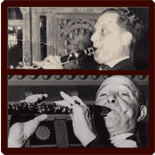Tarras and Brandwein
Dave Tarras, the Yiddish Melodies in Swing clarinetist, was brought
up in the world of klezmer, the traditional instrumental music of Eastern European
Jews. But he was no stranger to the New World technology of radio.
Apart from his longstanding gig on Yiddish Melodies in Swing, Tarras
was the musical director of the low-power WBBC (Brooklyn Broadcasting Company),
where he played old-fashioned bulgars and sweet waltzes between programs,
tailoring the name of his ensemble to whoever was footing the bill. His band
could start the afternoon as Dave Tarras and the WBBC Ensemble, transform fifteen
minutes later into Dave Tarras and the Breakstone Ensemble, and round out the
hour as Dave Tarras and the Stanton Street Clothiers Ensemble.
Key to Tarras's success were his extraordinary music reading ability and
his capacity to show up to a gig sober and on time. Neither quality was shared
by Tarras's chief rival, Naftule Brandwein -- the other leading contender
for the title of the twentieth century's greatest klezmer clarinetist.
Brandwein was Tarras's opposite in almost every respect. Unable to read a note
of music, he preferred the poker table to the bandstand and the liquor bottle
to just about everything else. Onstage he wore an Uncle Sam outfit wrapped in
Christmas lights, which blew up one night as his perspiration got out of hand.
His playing was as rough and wild as his temperament, laced with elements of
Greek, Turkish, and Gypsy music.
Brandwein was a fearless musician, always teetering on the edge of disaster.
A favorite of Murder Incorporated, for whom he performed in a famed hideaway
behind a Brooklyn candy store, the talented iconoclast left a lasting mark on
the development of klezmer music.
Aficionados of the genre argue to this day about which of the two klezmer masters,
Tarras or Brandwein, was the greatest. As far as who was better suited to radio,
history long ago passed definitive judgment.


